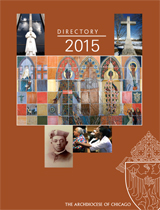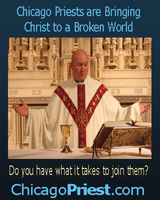Extension leader: Bring church's mission home

A regular feature of The Catholic New World, The InterVIEW is an in-depth conversation with a person whose words, actions or ideas affect today's Catholic. It may be affirming of faith or confrontational. But it will always be stimulating.
Father Jack Wall took over as president of Catholic Extension March 1, and served as pastor of Old St. Patrick Parish from 1983 until July 1 this year. In his new position, he said, he’s getting a new perspective on the “mission- driven” nature of the church— something he tried to emphasize at Old St. Pat’s, as well.
Catholic Extension supports the 84 “mission dioceses” of the church in the United States, dioceses where the economic need is so great or the number of Catholics so few that they cannot fully support themselves. Such dioceses are generally concentrated in the southern and western parts of the United States.
One of its ongoing challenges is maintaining its response to the needs of parishes and dioceses on the Gulf coast that were ravaged by Hurricane Katrina two years ago and its aftermath. So far, Catholic Extension has helped bring $6.5 million in aid to dioceses affected by the disaster.
Wall talked about his transition and Extension efforts with assistant editor Michelle Martin.
Catholic New World: What has the transition from Old St. Pat’s to Extension been like?
Father Jack Wall: It’s been exciting; it really has. I’m leaving Old St. Pat’s in wonderful hands. It has a great staff, a wonderful congregation and just an outstanding new pastor in Father Tom Hurley. We’ve had a seamless transition. Transitioning into Catholic Extension has been a real adventure. It’s broadening my own perspective of the American Catholic church. St. Pat’s has always had a strong sense of being a mission-driven church, and this really is an opportunity to express that experience of church that I think is really at the heart of all of us. The whole church is meant to be a mission-driven church and this is going to be a great opportunity to experience what that might mean.
CNW: In the wake of Katrina, St. Pat’s was one of the first parishes to offer aid. Did you visit the affected area then?
FJW: I did not, but people go down from St. Pat’s practically every weekend. The first thing that did happen was we called Bishop (William) Houck, who was president of Catholic Extension. He was already in Mississippi, in the office with Bishop (Thomas J.) Rodi, who was bishop of Biloxi. We happened to catch both of them at the same time, and we said is there some place that we could connect to?
We connected with St. Clare’s in Waveland, Miss. We’ve been working with them ever since then. It’s hard to imagine … I think everybody, especially in Chicago, when you think about water and the lakefront, even when we think of seiches, we think of something affecting a block or something like that. St. Clare’s was literally 100 yards from the ocean, or the Gulf. It was very close. But probably a mile back at least there was devastation. They say there was no debris, there was nothing to clean up, because everything was swept out to sea. The only thing that was left of the church was its concrete slab. It’s still there two years later. They’ve not been given permission to build.
CNW: I know you visited the Gulf Coast recently. What was your impression?
FJW: There’s still great suffering. The fact that two years have gone by, on one level, some people have been able to build and start anew, but in other places, the suffering is worse, because it’s two years in the making. It’s really a mixed experience. Some of it is because decisions have to be made. Are people going to rebuild in the same places where they were building, and if they are, what is that rebuilding going to look like? Just picking up on the St. Clare’s experience, they have not been allowed to rebuild. They won’t know whether they can rebuild or how they can rebuild, probably until December 2008, and so they are in a Quonset hut on the site of the church. Many of the homes in that area have not been able to be rebuilt—that’s the Mississippi side.
Interestingly, the places that were first up were all of the casinos. Other hotels haven’t been built, but the casinos were the first up.
The churches, though, are being rebuilt and restored. I was very pleased to see the work of Catholic Extension and the Parish Partnership program for the rebuilding of a number of churches in the city of Biloxi, Pass Christian, and a number of the communities in Mississippi.
Then you have the reality of New Orleans, which is a whole other matter. So many places, it really is literally a ghost town. You go there at night, and there’s just no lights. A few homes are the exceptions, which people have been able to rebuild because they had insurance or whatever. It has not been an easy experience.
CNW: Is New Orleans a mission diocese?
FJW: It is not technically, but because of the terrible devastation, Catholic Extension and the whole American church has tried to make a contribution to the rebuilding.
The story of hope alongside that continuing struggle is what I heard over and over again. Coming back after the flooding or after the devastation of the hurricane, people just stood and saw the devastation, and were really feeling this great sense of “Where do we go? What will happen?”
A beautiful story that was told by one person, but was echoed by many others, was of standing there in this rubble, looking at this scene, and a bus pulls up—a yellow school bus—and it’s from some Midwestern town, some Midwestern city, filled with a church community, coming and saying basically, how can we help? The message I’ve gotten over and over again is that the church was not only the first presence at the moment of the disaster, but it’s been the most consistent presence throughout. The church has been the sign of hope and the expression of hope and the experience of hope for the people of the Gulf states and the people of New Orleans.
This is what Parish Partnership has meant. We get letters here at Extension every week—copies of letters in which people sent one to us and one to a parish parish which continues to offer some sort of financial or other form of tangible help and service to the people.
CNW: Explain the Parish Partnership program.
FJW: The experience that happened with Bishop Houck and Bishop Rodi would be an example of it. Bishop Houck and Catholic Extension tried to figure out vehicles for aid in the Gulf Coast and New Orleans. They just put the word out to the dioceses of the United States, saying, “Hey, we’d be honored to be a vehicle to help local church communities help church communities in the Gulf Coast and in New Orleans.” More than 200 parishes have been involved in this process, just in relationship to the Gulf Coast and New Orleans. They’ve given financial support. They’ve visited and offered opportunities to clear up the rubble and debris. They’ve begun the process of rebuilding in many different places. The way this has occurred in the life of many church communities has been just outstanding.
In terms of the faith perspective, I always reach back to how at the very beginning, one of the ways in which we expressed who we were as Christians, a big message was, “See how they love one another. See how they care for one another.” I think that this moment in American church history is one moment in which that opportunity is there for local churches helping local churches, as it was in the early church.
It’s really been a mutual thing. It’s not one-sided. Youth groups, young adult groups, they’ve gone down and are transformed as well. We become more aware that we are at our best when we are for one another. It’s not just something where people are helping those in need. It raises all of us up. We become more aware of what we are meant to be as mission- centered, mission-driven church. I think especially for the young—seeing teens go down there and living their faith and praying with the community as they work with them is a very powerful experience.
Because of this, the Parish Partnership has grown. We said wouldn’t it be wonderful if this could be a vehicle in which the American Catholic church might connect on the parish level, that they might be able to be with and be for each other in a mutual way? In the last several months, we’ve expanded the parish partnership program to include a number of other places throughout the United States that are what we describe as a mission diocese.
Where we focus our attention at Catholic Extension is those communities that are the poorest in our country, or those most remote from the larger Catholic Community or from the resources needed to sustain a vibrant church experience. Even though we talk about the home mission dioceses, I really think it’s mission church America. We try to understand that our expression of church, how we are church—we cannot be church unless we become gift to one another and to the larger world. We cannot be a church just looking at ourselves. We’ve got to be in mission, and I think that’s one of the things that has been really awakened more deeply in me.
CNW: Aside from Katrina recovery, what areas does Extension need to work on now?
FJW: One of the clear shifts in the American Catholic church is the emerging Hispanic church in our country. Many of the places where the Hispanic community is growing are rural places. One of the gifts of the Catholic Church in America and to America is to continue to nurture the life of faith of immigrant communities.
The reality of the emerging Hispanic church and the Hispanic community and what that will mean for the enrichment of the Catholic Church experience and how Extension might be helpful to the process is clearly one of the areas we need to focus on.
America has become very urban, but in our faith tradition, there are always these questions that are thrown out and kind of haunt you. One of the haunting questions that Scripture’s always thrown out to me is, “What good can ever come out of Nazareth?” that quote that Nathaniel has. Whether we’re talking in the Archdiocese of Chicago, wherever you are, wherever your parish is, you’re in Nazareth. But in a special way, in the United States, some of these poorest places, these poorest dioceses, may be the places where transformation or a vision of the way the Gospel is calling is coming from. I think the Christian community has always got to be aware of that, what good comes out of the poorest towns, the poorest villages, the poorest hamlets of our country, and to be open to it.
We discover ourselves in a deeper way by being mission centered in our lives. The church is not for the church. The church is to be doing God’s work in the world. The church has a purpose.
To learn more about Catholic Extension, visit catholic-extension.org.
 Catholic
New World - Newspaper for the Archdiocese of Chicago
Catholic
New World - Newspaper for the Archdiocese of Chicago Archdiocese of Chicago Directory
Archdiocese of Chicago Directory Oficjalne wydawnictwo Archidiecezji Chicago w języku polskim
Oficjalne wydawnictwo Archidiecezji Chicago w języku polskim
